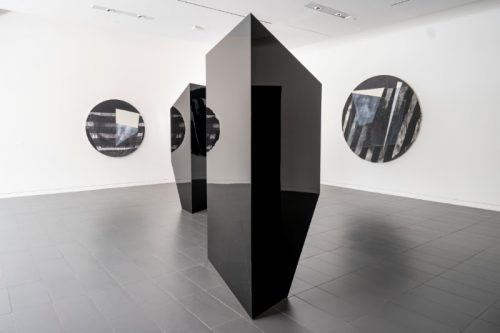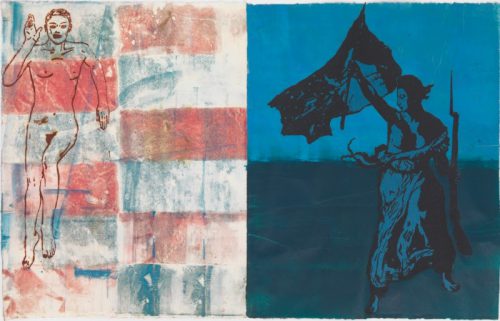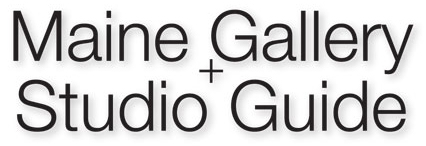
The Colby College Museum of Art creates academically robust and engaging exhibitions. This fall, the Colby Museum is pleased to present the following exhibitions: Torkwase Dyson: Nautical Dusk (through January 6, 2019), Darkness Visible: Goya Prints from the Lunder Collection (through January 20, 2019), Nancy Spero: Unbound (through January 20, 2019), and Currents 8: Carly Glovinski (through February 17, 2019).
Torkwase Dyson: Nautical Dusk
At the invitation of the Museum, the New Jersey-based artist Torkwase Dyson visited Waterville to consult archival materials related to Samuel Osborne (c. 1833–1904). Born into slavery on a Virginia plantation, Osborne migrated to Maine in 1865 and served as a Colby College janitor from 1867 to 1903. In the works she produced for Nautical Dusk, Dyson combines simple geometric forms infused with metaphorical associations found in obituaries of Osborne written by unnamed white authors. These texts raise questions about authorship, transmission, and self-determination, all issues that she will continue to unpack over the run of the show. Nautical Dusk features sculptures and paintings that explore these subjects in a formal register through intimacy, liquidity, and reflectiveness. What results are expanded dimensions of space. Occupying half the gallery is a work entitled Dusk, a monolithic ramp that functions as an architectural intervention, activating the space and inviting engagement or contemplation. It suggests a promontory, an outcropping from which to scan or surveil, but also a structure partially submerged.
Torkwase Dyson (b. 1973) was born in Chicago, Illinois, and spent her developmental years between North Carolina and Mississippi before earning her BFA from Virginia Commonwealth University and her MFA from the Yale School of Art. She was recently included in the 2018 group exhibition Between the Waters at the Whitney Museum of American Art and will be included in the 2019 Sharjah Biennial.

Currents 8: Carly Glovinski
Established by the Colby Museum in 2004, the Currents exhibition series is dedicated to emerging artists with connections to Maine. For the eighth installment of the series, Carly Glovinski has created a group of works for a two-part exhibition on the theme of landscape that is on view currently at the Colby Museum and the Waterville Public Library. At the Colby Museum the commissioned works include painted sculptures and works on paper inspired by works in the Lunder Collection, several of which are on view in an adjacent gallery arranged by the artist. For the portion of the exhibition mounted at the Waterville Public Library, Glovinski has produced a group of three-dimensional paintings that closely resemble books in the library’s collection. These painted objects are exhibited on the library’s shelves. Designed to be explored by the hand and eye, they can be discovered by library patrons via a finding aid.
The Currents 8 catalogue will be available in late 2018 and will feature essays by Lunder Curator of American Art Elizabeth Finch and the writer Heidi Julavits.
Carly Glovinski (b. 1981) holds a BFA from Boston University and has shown her work nationally. She grew up in Berwick, Maine, and has a studio in nearby Rollinsford, New Hampshire.

Darkness Visible: Goya Prints from the Lunder Collection
During his lifetime the Spanish artist Francisco de Goya (1746–1828) was known for his commissioned works, but his independently produced prints are arguably his greatest achievement. This focused exhibition from the Lunder Collection includes a bound copy of Goya’s Los Caprichos (1799), accompanied by a digital resource that allows visitors to see an image of each print in the order Goya established for the series. The exhibition also includes a 19th-century commentary, or “key” to the series, by an unknown writer.
Darkness Visible: Goya Prints from the Lunder Collection is organized to coincide with an exhibition of the work of Nancy Spero (1926–2009), one of many artists who have been inspired by Goya’s visionary creations as a graphic artist.

Nancy Spero: Unbound
For more than five decades, Nancy Spero (1926–2009) pioneered a feminist art practice that fiercely defied the social expectations imposed on women. Using a lexicon of appropriated imagery, Spero envisioned, as she observed in 1987, “all manner of processions, conflicts, interruptions and disruptions.” Her hybrid artworks made in protest against war and in celebration of the liberated female body constitute Nancy Spero: Unbound, an exhibition organized in conjunction with a concurrent presentation of Francisco Goya’s prints, which Spero first encountered as an aspiring young artist.
Spanning the artist’s entire career, Nancy Spero: Unbound includes one of her earliest surviving works: a lithograph dating from around 1950, depicting an ecstatic dancer whose outstretched limbs resist containment. In 1966, when Spero initiated a truculent series of drawings to protest the Vietnam War, she began to work primarily on and with paper, a material she preferred for its versatility and economy. She subsequently introduced the use of collaged images made from cutouts of her prints. She also joined paper sheets end to end to create vertical and horizontal scrolls, often composing on a monumental scale.
The expressions of ecstasy and protest that defined Spero’s early practice gave way to representations of the female subject as an “activator” in works derived from found and altered images, sometimes with accompanying quotations. Late in life Spero explored her visual lexicon in new and even more expansive sites, drawing and printing directly on the wall and revisiting her Vietnam War–era imagery to create one of her last major works, Maypole: Take No Prisoners II (2008), a towering, multi-part sculpture that serves as the exhibition’s arresting centerpiece.
Categories: Colby College Museum of Art, exhibitions, museum, shows, Waterville
Tags:

